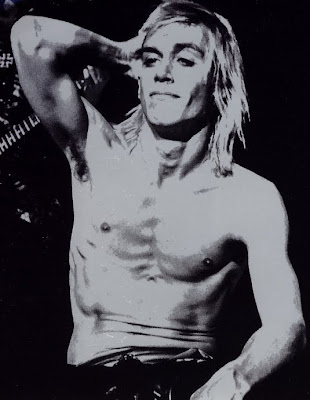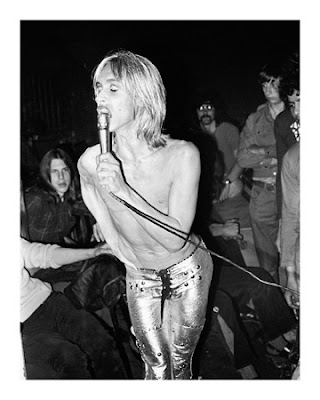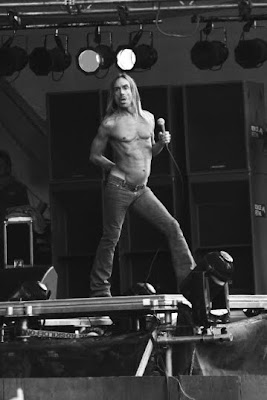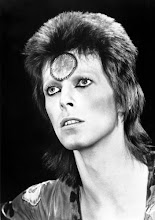
With his outrageous, cathartic, and at times dangerous stage antics, and the relentless rock & roll that accompanied them, Iggy Pop prefigured both '70s punk and '90s grunge. With his persona as that of the eternal misfit, saboteur of all convention, Pop has parlayed twisted social commentary, an affecting if limited vocal style, and unlikely survival smarts into a long career characterized by scant commercial success, sizable critical notice, and a fanatic cult.

Raised in a trailer park, James Osterberg played drums as a teen in a local garage band, the Iguanas. He dropped out of the University of Michigan in 1966 and went to Chicago, where he listened to urban blues on the South Side. He returned to Detroit as Iggy Stooge and, inspired by a Doors concert, formed the Stooges. They debuted on Halloween 1967 in Ann Arbor and were appropriately frightening onstage: Iggy contorting his shirtless torso, letting out primal screams, rubbing peanut butter and raw steaks over his body, gouging his skin with broken glass, diving into the crowd, all while the Stooges played raw, basic rock. Some thought the band the embodiment and the future of rock; others were appalled that they were so unrepentantly primitive.

Elektra, the Doors’ label, signed them in 1968. Though a decade later their first two albums would be hailed as seminal punk, they sold only moderately upon release. The band went through various personnel changes following the 1970 album Fun House, eventually breaking up, with Iggy retiring for over a year to kick a heroin addiction. Around this time, he ran into David Bowie, who resolved to resurrect Iggy’s career. Bowie regrouped some of the Stooges and produced Raw Power, a critical success.


A dispute with Bowie’s manager Tony DeFries forced Iggy and the re-formed Stooges onto the road without a manager. Through 1973 there was a return to drug addiction and by the next year the band nearly imploded. Iggy spent 1974-75 in L.A., trying to solve assorted legal problems. He committed himself to an L.A. mental hospital and was visited by Bowie (whose “Jean Genie” on the 1973 Aladdin Sane is said to be about Iggy). In 1976 Bowie took Iggy with him on his European tour, after which they settled in Berlin for three years. Concurrently, Bowie produced Pop’s The Idiot and Lust for Life, meditations on modern malaise that benefited from Bowie’s professionalism; other albums of this period, like Metallic K.O. and Kill City, were semi-bootleg issues of older Stooges-era material.

In 1977 Iggy toured the U.S. with Bowie (unannounced) playing keyboards; Blondie was their opening act. Signing to Arista in the late ’70s, Iggy released New Values, an album of trenchant rock; his other Arista work, however, suggested the beginnings of self-¬parody and sold dismally. Publishing his autobiography, I Need More, and signing with Blondie guitarist Chris Stein’s Animal label in 1982, he put out another strong collection, Zombie Birdhouse. Yet only when “China Girl,” co-written by Pop and David Bowie, appeared on the latter’s 1983 Let’s Dance and became a hit for Bowie did Iggy achieve a measure of financial stability and mainstream interest.



With Bowie producing and ex–Sex Pistol Steve Jones on guitar, Blah Blah Blah showed Iggy attempting his most accessible music; peaking at #75, it fared nearly as well as The Idiot (#72, 1977), but alienated some of his hard-core following. Beginning in the mid-’80s, Pop began accepting character roles in movies (Sid and Nancy, The Color of Money, Cry-Baby, the kids movie Snow Day, and Dead Man); he was sought after as punk’s elder statesman, even though Iggy’s outrageousness by then was less a daily reality than a determined role. Married in 1984 and a proponent of at least his version of domestic bliss, Iggy reserved his animal spirits for recording. Instinct was Pop at his most metallic; Brick by Brick had him trying again for accessibility and duetting with Kate Pierson of the B-52’s (“Candy”). Lauded by critics, American Caesar was his return to raw form, helped out with guest vocals on two tracks by one of his chief successors, Henry Rollins. If anything, Naughty Little Doggie rocked harder, and by the mid-’90s Pop enjoyed genuine cult-legend status. He was invoked as muse/hero in Irvine Welsh’s Trainspotting and Danny Boyle’s film of that novel (which used “Lust for Life” on its soundtrack); filmmaker Todd Haynes patterned Velvet Goldmine on the Pop-Bowie relationship and Bowie; and in 1997 Joan Jett and the Blackhearts and the Red Hot Chili Peppers were featured on We Will Fall: The Iggy Pop Tribute. Pop ended the century with Avenue B, a dark, string-laden work, influenced by his fondness for Frank Sinatra. Musings on turning 50 and the fallout from his recent divorce, the album was intensely introspective. In 2003 the Stooges reunited, collaborating on Iggy’s the Skull Ring and performing live across Europe and the U.S. Channeling their momentum as a working band, Iggy and the Asheton brothers finally found their way back into the studio to record their first album since 1973’s Raw Power. The Weirdness, produced by Steve Albini, was released on March 7th, 2007.
Various Live Videos of Iggy Pop
Iggy Pop and The Stooges, Live in Cincinnati, 1970
IGGY POP_I WANNA BE YOUR DOG ON SKYDOG TV
Iggy Pop - The Passenger(Live)-1977
Iggy Pop - Sixteen
Rock On Music Lovers!!
-Stereo
If you liked this article then make sure you subscribe to the feed via RSS It's Free. You can also follow me on Twitter too!
Check out the Retro Rebirth Design Catalog


No comments:
Post a Comment